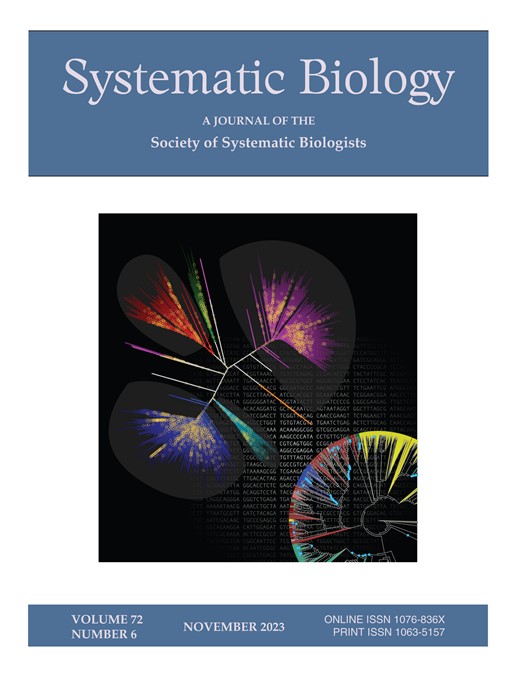Non-adaptive Radiation Promotes Phenotypic Diversification and Convergent Evolution of Aposematic Mimicry in a Highly Diverse Genus of Megaloptera
IF 5.7
1区 生物学
Q1 EVOLUTIONARY BIOLOGY
引用次数: 0
Abstract
Evolutionary radiations are considered key processes underlying the origin of biodiversity. Notably, the mechanisms driving these radiations can vary across organisms and often involve a complex interplay of abiotic and biotic factors. Empirical studies on evolutionary history are crucial for validation of multiple hypothesis regarding the mode of evolutionary radiations. Within the aquatic insect order Megaloptera, the genus Protohermes is the most speciose clade with 90 described species, accounting for around 22% of the total ordinal diversity. Protohermes species are featured by the limited dispersal ability, primarily occurring across the Oriental region, and a range of diversified phenotypes, e.g., highly divergent genital characters, and mimetic coloration alongside shifts in biological rhythm—from nocturnal to diurnal activities. Here we infer the spatiotemporal mode of diversification and associated driving factors of the Protohermes radiation as a test case for exploring the processes and potential mechanisms of evolutionary radiations. We present the first time-calibrated phylogeny of Protohermes using genome-scale data of ultraconserved elements (UCEs) and mitochondrial genes with a comprehensive taxon sampling. Our results reveal a mid-Cretaceous stem age of Protohermes, followed by a recent and steady diversification during the Neogene. Estimation of historical biogeography suggests the genus likely originated from a broad range including the Himalayas-Hengduan Mountains + Indochina + Borneo, with the first two areas serving as the center of early diversification. Our results further suggest that vicariance events, likely attributed to the Cenozoic Himalayan orogeny as well as climate change in East Asia, triggered speciation that coincided with the accumulation of genital divergence. Further enhancement of genital and phenotypic diversification may have been promoted by secondary contacts of allopatric or parapatric lineages following the build-up of species richness, likely facilitating species coexistence and lineage accumulation. We argue that the current species diversity of Protohermes likely resulted from a non-adaptive radiation. Our results highlight the role of geographic vicariance and sexual selection in driving the species and phenotypic diversification in insects.非适应性辐射促进大翅目高多样性属的警示拟态表型多样化和趋同进化
进化辐射被认为是生物多样性起源的关键过程。值得注意的是,驱动这些辐射的机制可能因生物而异,并且通常涉及非生物和生物因素的复杂相互作用。对进化历史的实证研究对于验证关于进化辐射模式的多重假设至关重要。在水生昆虫目大翅目中,原爱马仕属是物种最多的分支,共有90种,约占总有序多样性的22%。原始爱马仕物种的特点是有限的传播能力,主要发生在东方地区,并且具有一系列多样化的表型,例如,高度分化的生殖器特征,模仿的颜色以及生物节律的变化-从夜间活动到白天活动。本文通过对原爱马仕辐射多样性的时空模式和驱动因素的推断,为探索进化辐射的过程和潜在机制提供了实验依据。我们利用超保守元件(UCEs)和线粒体基因的基因组尺度数据,通过全面的分类群采样,首次提出了原生爱马仕的时间校准系统发育。我们的研究结果揭示了白垩纪中期的原始爱马仕,随后在新近纪出现了稳定的多样化。历史生物地理学估计表明,该属可能起源于包括喜马拉雅-横断山脉+印度支那+婆罗洲在内的广泛范围,其中前两个地区是早期多样化的中心。我们的研究结果进一步表明,可能归因于新生代喜马拉雅造山运动和东亚气候变化的变异事件引发了与生殖分化积累相一致的物种形成。在物种丰富度积累之后,异域或异域谱系的二次接触可能促进了生殖器官和表型多样化的进一步增强,这可能促进了物种共存和谱系积累。我们认为,原始爱马仕的物种多样性可能是由非适应性辐射造成的。我们的研究结果强调了地理变异和性选择在驱动昆虫物种和表型多样化中的作用。
本文章由计算机程序翻译,如有差异,请以英文原文为准。
求助全文
约1分钟内获得全文
求助全文
来源期刊

Systematic Biology
生物-进化生物学
CiteScore
13.00
自引率
7.70%
发文量
70
审稿时长
6-12 weeks
期刊介绍:
Systematic Biology is the bimonthly journal of the Society of Systematic Biologists. Papers for the journal are original contributions to the theory, principles, and methods of systematics as well as phylogeny, evolution, morphology, biogeography, paleontology, genetics, and the classification of all living things. A Points of View section offers a forum for discussion, while book reviews and announcements of general interest are also featured.
 求助内容:
求助内容: 应助结果提醒方式:
应助结果提醒方式:


